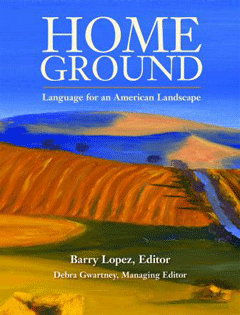The Language of Landscape
Air Date: Week of March 9, 2007

Home Ground: Language for an American Landscape, edited by Barry Lopez and Debra Gwartney. (Courtesy of Trinity University Press)
Living on Earth launches a new series exploring features of the American landscape. The series is based on the new book Home Ground: Language for an American Landscape, edited by Barry Lopez and Debra Gwartney. In this first installment, Oregon writer John Daniel muses on the word “cascade.”
Transcript
GELLERMAN: It’s Living on Earth. I’m Bruce Gellerman. Just ahead it sounds a little cuckoo a painting brings music to the ears of bird scientists. But first, we begin a new series on Living on Earth called “Home Ground.”
[MUSIC: Daniel Lanois “O Marie” from ‘Arcadie’ (Daniellanois.com - 2005)]
GELLERMAN: Can you really say you know a place, I mean really know a place, until you can describe the landscape the pattern of folds and features that make a place unique? Learning to describe a landscape is part of making it our own, claiming it as a place we care about.
Nature writer Barry Lopez has devoted his life to describing landscapes in intimate detail. So he was surprised to find not long ago, that no one had ever published a dictionary of American landscape terms. So Lopez and fellow writer Debra Gwartney set out to do just that.
They asked 45 other writers to craft accurate—but lyrical—definitions of landscape features they know and love, ranging from the commonplace like “field” and “desert” to the obscure like: “ganderbrush”, “hogback ridge”, and “witness tree”.
The result is a new collection called Home Ground: Language for an American Landscape. And over the next few months, we’ll feature a series of entries from the book, read by the authors.

Home Ground: Language for an American Landscape, edited by Barry Lopez and Debra Gwartney. (Courtesy of Trinity University Press)
We begin this week with Oregon writer John Daniel reading his definition of one of the signature landscape features of his part of the country: “Cascade”.
DANIEL: Cascade. Mountain streams like to descend in stair step series of short falls and brief pools. In these cascades water alternates between two energy states. Much like air shifting between super and subsonic flow. The white water of the falls is the fluvial equivalent of a sonic boom. Cascade is used more broadly to mean a rocky stretch of white water less steep than a waterfall but steeper than a rapid.
The cascades of the Columbia River formed several centuries ago when a massive slide filled a channel in the mid Columbia Gorge presented Louis and Clark’s core of discovery with a three miles stretch of chutes and falls boiling in a most horrible manner, according to William Clark’s journal.
Rafting or boating the gorge was the last leg of the Oregon Trail for many early immigrants. Some lost all they owned to the Cascades and some lost their lives. Now drowned in slack water behind Bonneville Dam this reach of river gave the Cascade Range its name.
[MUSIC: Don Williams “Till The Rivers All Run Dry” from ‘Don Williams: Anthology’ (UMG Recordings – 2000)]
GELLERMAN: John Daniel lives and writes in the hills just outside of Eugene, Oregon. His definition of “Cascade” is included in the new book Home Ground: Language for an American Landscape, edited by Barry Lopez and Debra Gwartney. In the coming weeks, we’ll hear other entries from the book including definitions of such landscape features as: “Blind Creek”, “Kiss Tank”, and “Anchor Ice”.
Links
Living on Earth wants to hear from you!
Living on Earth
62 Calef Highway, Suite 212
Lee, NH 03861
Telephone: 617-287-4121
E-mail: comments@loe.org
Newsletter [Click here]
Donate to Living on Earth!
Living on Earth is an independent media program and relies entirely on contributions from listeners and institutions supporting public service. Please donate now to preserve an independent environmental voice.
NewsletterLiving on Earth offers a weekly delivery of the show's rundown to your mailbox. Sign up for our newsletter today!
 Sailors For The Sea: Be the change you want to sea.
Sailors For The Sea: Be the change you want to sea.
 The Grantham Foundation for the Protection of the Environment: Committed to protecting and improving the health of the global environment.
The Grantham Foundation for the Protection of the Environment: Committed to protecting and improving the health of the global environment.
 Contribute to Living on Earth and receive, as our gift to you, an archival print of one of Mark Seth Lender's extraordinary wildlife photographs. Follow the link to see Mark's current collection of photographs.
Contribute to Living on Earth and receive, as our gift to you, an archival print of one of Mark Seth Lender's extraordinary wildlife photographs. Follow the link to see Mark's current collection of photographs.
 Buy a signed copy of Mark Seth Lender's book Smeagull the Seagull & support Living on Earth
Buy a signed copy of Mark Seth Lender's book Smeagull the Seagull & support Living on Earth

